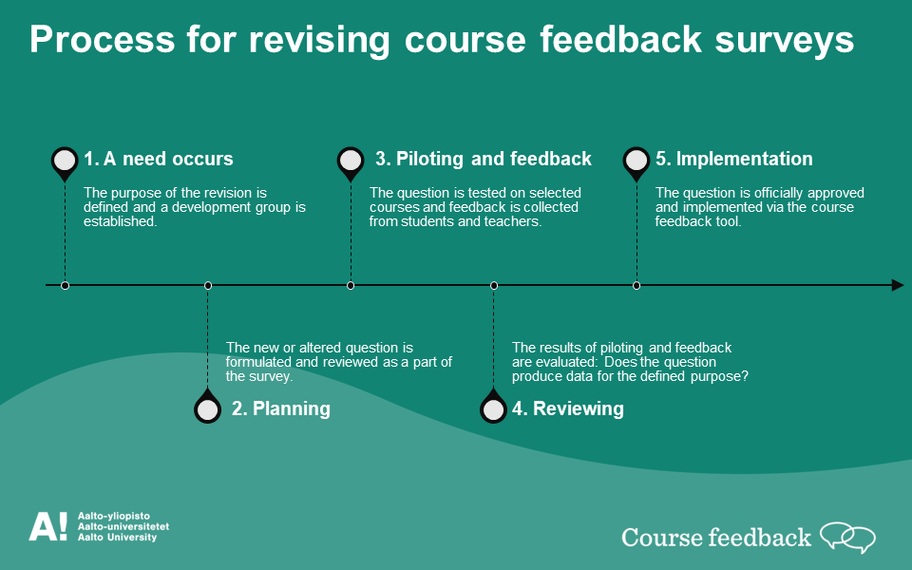Course feedback questions
Additionally, you'll find information about course-specific questions and the question library, along with tips for crafting effective feedback questions and guidelines for revising existing Aalto and school-specific questions.
Aalto questions
Aalto questions are common to all courses at Aalto University. They are automatically included in every course's end-of-course feedback survey:
|
Ymmärsin, mitä minun odotettiin oppivan tällä kurssilla. 5 – Täysin samaa mieltä |
Jag förstod vad jag förväntades lära mig på den här kursen. 5 – Helt av samma åsikt |
I understood what I was expected to learn in this course. 5 – Strongly agree |
|
Opetushenkilöstön opetustyö (esim. luennot, ohjaus, palaute) tuki oppimistani. 5 – Täysin samaa mieltä |
Undervisningspersonalens undervisningsarbete (t.ex. föreläsningar, handledning, respons) stödde mitt lärande på kursen. 5 – Helt av samma åsikt |
The teaching (e.g., lectures, advising, feedback) provided by the teaching staff supported my learning. 5 – Strongly agree |
|
Kurssin oppimisaktiviteetit (esim. tehtävät, harjoitustyöt, keskustelut) tukivat oppimistani. 5 – Täysin samaa mieltä |
Kursens lärandeaktiviteter (t.ex. uppgifter, övningsarbeten, diskussioner) stödde mitt lärande på kursen. 5 – Helt av samma åsikt |
The learning activities in the course (e.g., assignments, projects, discussions) supported my learning. 5 – Strongly agree |
|
Kurssin käytännön järjestelyt (esim. aikataulut, tiedotus) toimivat hyvin. 5 – Täysin samaa mieltä |
De praktiska arrangemangen på kursen (t.ex. tidtabeller, information) fungerade väl. 5 – Helt av samma åsikt |
The practical arrangements of the course (e.g., schedules, communication) worked well. 5 – Strongly agree |
The questions below were the Aalto questions from autumn 2022 to spring 2025. They are not in use anymore, but listed here for your information:
|
Yleisarvioni kurssista kokonaisuutena E = Ei perusteita vastata |
Allmän bedömning av kursen som helhet E = Inte tillämpligt |
My overall assessment of the course E = Not applicable |
|
Tapa, jolla opetus toteutettiin (esim. luento, laboratoriotyöt, ryhmätyöt, verkko-opetus, harjoitukset) tuki oppimistani E = Ei perusteita vastata |
Undervisningssätten (t.ex. föreläsningar, laboratoriearbeten, nätbaserad undervisning, övningsarbeten) var ett stöd för inlärningen på kursen E = Inte tillämpligt |
The teaching methods (lectures, labs, group work, online study, assignments etc.) supported my learning E = Not applicable |
|
Olen tyytyväinen omaan opiskelupanokseeni tällä kurssilla E = Ei perusteita vastata |
Jag är nöjd med min studieinsats på kursen E = Inte tillämpligt |
I am pleased with my study effort on this course E = Not applicable |
|
Kurssin suorittaminen vaati minulta siitä saatavaan opintopistemäärään verrattuna (ohjeistuksen mukainen mitoitus: 1 ECTS = 27 tuntia) E = Ei perusteita vastata |
Jämfört med studiepoängen som ges för kursen krävdes det av mig för att genomföra kursen (vägledande mått: 1 ECTS = 27 timmar) E = Inte tillämpligt |
According to the guidelines, one credit (ECTS) requires 27 hours of student work. Compared with this, the completion of the course required E =Not applicable |
| Mitkä asiat kurssilla edistivät opetuksen saavutettavuutta, osallistavuutta ja vähensivät syrjintää (esimerkiksi valituissa opetus- ja arviointimetodeissa, opetusmateriaaleissa tai kurssin oppimisympäristöissä)? | Vilka faktorer främjade tillgängligheten och delaktigheten samt minskade diskrimineringen i undervisningen i kursen (till exempel vad gäller undervisnings- och bedömningsmetoderna, undervisningsmaterialen eller lärmiljöerna)? | Which factors in the course served to promote the accessibility of the teaching, encourage participation, and reduce discrimination (e.g. in the selected teaching and assessment methods, course material, or learning environment)? |
School-specific questions
On top of Aalto questions, each school and unit has their own school- or unit-specific questions. These questions cover topics that this school or unit considers important for the development of teaching. You'll find the school- and unit-specific questions below. These questions will also appear automatically in the feedback survey:
|
Oma läsnäoloprosenttini opetustapahtumiin oli arviolta 5 – 81–100% |
Jag uppskattar att min närvaroprocent vid undervisningstillfällena var 5 – 81–100% |
I estimate my own attendance percentage at 5 – 81–100% |
|
Kurssi vastasi ilmoitettua sisältöä ja tavoitteita. 5 – Täysin samaa mieltä |
Kursen motsvarade det innehåll och de mål som angetts. 5 – Helt av samma åsikt |
The course content and objectives corresponded to those of the course description. 5 – Strongly agree |
|
Toteutuneet opetusajat vastasivat Sisussa ilmoitettuja opetusaikatauluja. 5 – Täysin samaa mieltä |
De faktiska undervisningstiderna motsvarade de undervisningsscheman som meddelats i Sisu. 5 – Helt av samma åsikt |
The teaching schedule corresponded to that announced in Sisu. 5 – Strongly agree |
| Halutessasi voit täydentää vastaustasi toteutuneiden opetusaikojen osalta. | Om du vill kan du komplettera ditt svar om de faktiska undervisningstiderna. | If you wish you can supplement your answer regarding the teaching schedules. |
|
Kurssin arviointikriteerit ilmoitettiin selkeästi kurssin alussa. 5 – Täysin samaa mieltä |
Bedömningskriterierna för kursen förklarades tydligt i början av kursen. 5 – Helt av samma åsikt |
The assessment criteria for the course were clearly explained at the beginning of the course. 5 – Strongly agree |
| Miten kehittäisit kurssia? | Hur skulle du utveckla kursen? | How would you develop the course? |
|
Palautettani voidaan käsitellä ja siitä voidaan muodostaa yhteenveto, vaikka alle 5 opiskelijaa on antanut palautetta. Kyllä |
Respons som jag har gett kan behandlas och sammanfattas även om färre än 5 studerande har gett respons. Ja |
Feedback I have given can be processed and a summary can be made of it even if less than 5 students have given feedback. Yes |
|
Opetus oli 5 – Erinomaista |
Undervisningen var 5 – Utmärkt |
Teaching was 5 – Excellent |
|
Kurssin suorittaminen vaati minulta siitä saatavaan opintopistemäärään verrattuna (ohjeistuksen mukainen mitoitus: 1 ECTS = 27 tuntia) 5 – Huomattavasti enemmän aikaa (+50%) |
Jämfört med studiepoängen som ges för kursen krävdes det av mig för att genomföra kursen (vägledande mått: 1 ECTS = 27 timmar) 5 – Avsevärt längre tid (+50%) |
According to the guidelines, one credit (ECTS) requires 27 hours of student work. Compared with this, the completion of the course required 5 – Considerably more time (+50%) |
|
Oppimisympäristö kurssilla oli inklusiivinen ja kannustava. 5 – Täysin samaa mieltä |
Lärmiljön på kursen var inkluderande och uppmuntrande. 5 – Helt av samma åsikt |
The learning environment in the course was inclusive and supportive. 5 – Strongly agree |
| Kerro tarkemmin, jos jokin haittasi inklusiivisuutta oppimisympäristössä. | Berätta närmare om eventuella hinder för en inkluderande lärmiljö. | Please elaborate if anything hindered inclusivity in the learning environment. |
|
Kurssi auttoi minua pohtimaan kestävyyden (esim. sosiaalisen tai ekologisen kestävyyden) teemoja. 5 – Täysin samaa mieltä |
Kursen hjälpte mig att fundera på teman i anknytning till hållbarhet (t.ex. ekologisk eller social hållbarhet). 5 – Helt av samma åsikt |
The course engaged me to reflect on issues related to sustainability (e.g., ecological or social sustainability). 5 – Strongly agree |
| Mitä muita ajatuksia sinulla on liittyen kestävyysteemoihin kurssilla? | Vilka andra tankar har du om hållbarhetsteman på kursen? | What other thoughts do you have regarding sustainability topics on the course? |
| Mikä kurssilla oli hyvää? Mikä edisti oppimistasi? | Vad var bra på kursen? Vad stödde ditt lärande? | What was good about the course? What supported your learning? |
| Miten kehittäisit kurssia (esim. kurssitehtäviä, opetusteknologiaa, kurssin teemoja, muuta)? | Hur skulle du utveckla kursen (t.ex. inlämningsuppgifter, teknologi i undervisningen, teman på kursen, annat)? | How would you develop the course (e.g., assignments, learning technology, topics, other)? |
|
Miten kurssin työmäärä vertautuu muihin samantasoisiin kursseihin? 5 – Huomattavasti vaativampi |
Hur kan kursens arbetsbelastning jämföras med andra kurser på samma nivå? 5 – Mycket mer krävande |
How does the workload of the course compare to other courses on the same level? 5 – Much more demanding |
| Mitkä seikat kurssista olivat hyödyllisiä sinulle ja auttoivat tukemaan oppimistasi? | Vilka aspekter av kursen var till nytta för dig och hjälpte till att stödja ditt lärande? | What aspects of the course were beneficial to you and helped support your learning? |
| Miten muuttaisit kurssia? Oliko kurssin aikana ongelmia? | Hur skulle du förändra kursen? Fanns det problem under kursen? | How would you change the course? Were there problems during the course? |
|
Koin kurssin vaatiman työmäärän 5 – Huomattavan suurena kurssin opintopisteisiin nähden |
Jag upplevde kursens arbetsbelastning 5 – Avsevärt stor med tanke på kursens studiepoäng |
I found the workload of the course to be 5 – Very heavy compared to the credits I earned for it |
| Yleisiä kommentteja tai kehittämisajatuksia (esim. kurssimateriaalista, opetusmuodoista, suoritustavoista, kurssin ilmapiiristä tai muista saavutettavuusasioista) | Almänna kommentarer eller förslag till förbättringar (t.ex. i fråga om kursmaterialet, undervisningsformerna, tillvägagångssätten, kursatmosfären eller andra saker i tillgängliheten) | General comments and suggestions (on such matters as course material, teaching methods, course arrangements, ways of completing the course, course atmosphere or other accessibility issues) |
|
Ennakkotietoni olivat riittävät kurssilla menestymiseen. 5 – Täysin samaa mieltä |
Jag hade tillräckliga förkunskaper för att klara mig bra på kursen. 5 – Helt av samma åsikt |
My prior knowledge was sufficient for doing well in the course. 5 – Strongly agree |
| Mikä kurssilla oli hyvää? Mikä edisti oppimistasi? | Vad var bra på kursen? Vad stödde ditt lärande? | What was good about the course? What supported your learning? |
| Haittasiko jokin asia oppimistasi tai osallistumistasi kurssilla (esim. ilmapiiri, oppimisympäristö, saavutettavuuspuutteet, epäasiallinen käytös)? Jos haittasi, kerro tarkemmin. | Påverkade någonting ditt lärande eller ditt deltagande på kursen negativt (t.ex. atmosfären, lärmiljön, brister i tillgängligheten, osakligt bemötande)? Om så var fallet, beskriv närmare. | Did something hinder your learning or participation in the course (e.g., atmosphere, learning environment, accessibility issues, inappropriate behaviour)? If so, please elaborate. |
| Miten kehittäisit kurssia? | Hur skulle du utveckla kursen? | How would you develop the course? |
|
Uskon, että kurssilla oppimani asiat ovat minulle hyödyllisiä tulevaisuudessa. 5 – Täysin samaa mieltä |
Jag tror det jag lärde mig under kursen kommer att vara till nytta för mig i framtiden. 5 – Helt av samma åsikt |
I think I will benefit from the things learnt on the course. 5 – Strongly agree |
|
Yksi opintopiste vastaa mitoituksen mukaan 27 tunnin työskentelyä. Kurssin suorittaminen vaati siitä saatavaan opintopistemäärään suhteutettuna 5 – Huomattavasti enemmän aikaa |
Enligt dimensioneringen motsvarar en studiepoäng ungefär 27 timmar arbete. Jämfört med studiepoängen som kursen ger krävdes det av mig 5 – Betydligt mer tid |
According to the workload estimation, one credit (ECTS) corresponds to 27 hours of student work. Compared with this, the completion of the course required 5 – Considerably more time |
| Mikä kurssilla oli hyvää? Mikä edisti oppimistasi? | Vad var bra på kursen? Vad stödde ditt lärande? | What was good about the course? What supported your learning? |
| Miten kehittäisit kurssia? | Hur skulle du utveckla kursen? | How would you develop the course? |
| Onko sinulla palautetta kurssin ilmapiiriin, oppimisympäristöön tai saavutettavuuteen liittyen? | Har du respons på atmosfären, lärmiljön eller tillgängligheten på kursen? | Do you have feedback regarding the atmosphere, learning environment, or accessibility? |
|
Minulla oli riittävästi aikaa kurssin suorittamiseen sekä kurssilla opeteltujen asioiden omaksumiseen. Kyllä |
Jag hade tillräckligt med tid för att genomföra kursen och lära mig innehållet. Ja |
I had enough time to complete the course and internalize the content. Yes |
|
Jos vastasit ei, niin valitse syy alla olevista (voit valita useamman).
|
Om du svarade nej, välj orsak(er) nedan (du kan välja flera alternativ).
|
If you answered no, select the reason/s below (check all that apply).
|
| Mikä kurssilla oli hyvää? Mikä edisti oppimistasi? | Vad var bra på kursen? Vad stödde ditt lärande? | What was good about the course? What supported your learning? |
| Haittasiko jokin asia oppimistasi tai osallistumistasi kurssilla (esim. ilmapiiri, oppimisympäristö, saavutettavuuspuutteet, epäasiallinen käytös)? Jos haittasi, kerro tarkemmin. | Påverkade någonting ditt lärande eller ditt deltagande på kursen negativt (t.ex. atmosfären, lärmiljön, brister i tillgängligheten, osakligt bemötande)? Om så var fallet, beskriv närmare. | Did something hinder your learning or participation in the course (e.g., atmosphere, learning environment, accessibility issues, inappropriate behaviour)? If so, please elaborate. |
| Miten kehittäisit kurssia? | Hur skulle du utveckla kursen? | How would you develop the course? |
|
Palautettani voidaan käsitellä ja siitä voidaan muodostaa yhteenveto, vaikka alle 5 opiskelijaa on antanut palautetta. Kyllä |
Respons som jag har gett kan behandlas och sammanfattas även om färre än 5 studerande har gett respons. Ja |
Feedback I have given can be processed and a summary can be made of it even if less than 5 students have given feedback. Yes |
|
Kuinka todennäköisesti suosittelisit tätä kurssia ystäville ja tuttavillesi? Erittäin epätodennäköisesti - Erittäin todennäköisesti |
Hur sannolikt är det att du skulle rekommendera kursen till dina vänner och bekanta? Mycket osannolikt - Mycket sannolikt |
How likely would you recommend this course to your friends and family? Very unlikely - Very likely |
| Mikä kurssilla oli hyvää? Mikä edisti oppimistasi? | Vad var bra på kursen? Vad stödde ditt lärande? | What was good about the course? What supported your learning? |
| Haittasiko jokin asia oppimistasi tai osallistumistasi kurssilla (esim. ilmapiiri, oppimisympäristö, saavutettavuuspuutteet, epäasiallinen käytös)? Jos haittasi, kerro tarkemmin. | Påverkade någonting ditt lärande eller ditt deltagande på kursen negativt (t.ex. atmosfären, lärmiljön, brister i tillgängligheten, osakligt bemötande)? Om så var fallet, beskriv närmare. | Did something hinder your learning or participation in the course (e.g., atmosphere, learning environment, accessibility issues, inappropriate behaviour)? If so, please elaborate. |
| Miten kehittäisit kurssia? | Hur skulle du utveckla kursen? | How would you develop the course? |
|
Palautettani voidaan käsitellä ja siitä voidaan muodostaa yhteenveto, vaikka alle 5 opiskelijaa on antanut palautetta. Kyllä |
Respons som jag har gett kan behandlas och sammanfattas även om färre än 5 studerande har gett respons. Ja |
Feedback I have given can be processed and a summary can be made of it even if less than 5 students have given feedback. Yes |
|
Kurssilla opituista asioista on hyötyä minulle. 5 – Täysin samaa mieltä |
Jag har nytta av det jag lärde mig på kursen. 5 – Helt av samma åsikt |
The things that were taught in the course are useful to me. 5 – Strongly agree |
| Mikä kurssilla oli hyvää? Mikä edisti oppimistasi? | Vad var bra på kursen? Vad stödde ditt lärande? | What was good about the course? What supported your learning? |
| Haittasiko jokin asia oppimistasi tai osallistumistasi kurssilla (esim. ilmapiiri, oppimisympäristö, saavutettavuuspuutteet, epäasiallinen käytös)? Jos haittasi, kerro tarkemmin. | Påverkade någonting ditt lärande eller ditt deltagande på kursen negativt (t.ex. atmosfären, lärmiljön, brister i tillgängligheten, osakligt bemötande)? Om så var fallet, beskriv närmare. | Did something hinder your learning or participation in the course (e.g., atmosphere, learning environment, accessibility issues, inappropriate behaviour)? If so, please elaborate. |
| Miten kehittäisit kurssia? | Hur skulle du utveckla kursen? | How would you develop the course? |
Course-specific questions
In the course feedback tool in MyCourses, the teacher has the opportunity not only to collect feedback with surveys during the course, but also to add their own questions to the end-of-course feedback survey. You have access to pre-formulated questions, which can be found further down on this page and in the question library of the course feedback tool, available in three languages. If you want to create your own questions, you can familiarize yourself with the tips below and see the available question types in the instructions of the course feedback tool.
How to formulate your own feedback questions?
- In one question, ask only one thing.
Questions like “What worked well and what should be improved?” will result in confusing responses where it is difficult to define with certainty which category the student meant. So ask only about one thing in one question. -
Define whether your question is quantitative or qualitative.
Are you looking for qualitative or quantitative data as a result? If you are out for a number, it is good to offer pre-defined response options. If you use an open field in a quantitative question, you might end up with responses including both numeric responses and verbal definitions. It is time consuming to go through this kind of data.How much time did you use for this assignment?
Possible responses: a lot, about three hours, relatively ok, a bit too little, 1,5hHow much time did you use for this assignment?
Options:
Less than an hour
1-2h
2-3h
Over 3h - Consider the ethical perspective.
We don't collect delicate information (e.g. concerning a person's health or convictions), or information that could make it possible to recognize who gave the feedback.
The feedback survey is shared between all teachers of a course. It is good to coordinate the content of the survey together and make sure that all teachers are aware of the content. Questions concerning any single person should be avoided. We collect feedback about actions and circumstances, not persons and their personal qualities. -
Keep the number of questions moderate.
Ask only about things that you can't get information on otherwise. If you can get the same information through analytics tools in MyCourses, it is most probably better to use that information channel. This saves your students' time for the most central contents in the feedback survey.What information will you actually use and how? According to Principles of feedback in education at Aalto University feedback should have an impact. It is best to focus on themes you're developing now or planning to develop soon, and leave other themes for later. It is good to pay attention to workload when developing your courses and yourself as a teacher. Small concrete development steps will take you in the right direction more sustainably and predictably than big and fast changes.
Feedback during the course vs. Feedback at the end of the course
During the course, it makes sense to collect feedback about topics that can still be improved during the same course. In practice this can mean instructing the students better, adding support material, or choosing another tool or group work approach. Here are some ideas for feedback during the course:
- The rhythm of the teaching session, the amount of content
- Course practicalities and arrangements
- Preferred working methods
- Re-capping needs before the final exam or handing in a coursework
- New teaching methods used or experimented on the course
- Digital platforms or tools used
Even if you give students a chance to give feedback during the lectures and by email, it is also recommended to offer a channel where the feedback and the feedback-giver cannot be connected. We come from different backgrounds, and for some students approaching the teacher is out of the question, or giving feedback can involve a fear of losing face.
Questions requiring a more holistic development approach are best left in the end-of-the-course feedback survey. This kind of topics might be difficult to change during the same course implementation. It may also be easier for the students to assess them at the end of the course.
Updating Aalto and school-specific questions
The process for revising course feedback surveys is developed to support schools in revising their set of questions or adding new questions to the end-of-course survey. It can also be used for revising or adding Aalto questions.
Every school has a decision-making body regarding educational matters. That body can also make decisions about course feedback questions. In BIZ it is EMT, in ENG it is MOOR and KOOR, and in ELEC it is OpLaa. For other schools it is the vice dean of education until some other decision is taken. For Aalto questions the decision-making body is LESG.
Teacher services offer support throughout this process. Do not hesitate to contact Teacher services through MyTeaching Support.

Course feedback in Aalto University
Course feedback is a unique part of the feedback portfolio in Aalto University and it reaches students in all phases of their studies and is collected systematically throughout Aalto. Hearing the voice of students is vital for the development of teaching and education as well as for quality assurance and for improving study-related services. The course feedback tool can be found in MyCourses. Feedback is used on multiple levels in many ways and its utilisation is a special focus area at Aalto.

Main page for instructions of course feedback tool
At Aalto University, course feedback is collected from almost all courses. On these pages you will find teacher's instructions for using the course feedback tool on MyCourses.

Course feedback as a course element
Course feedback is a unique part of the feedback portfolio at Aalto university and it reaches students in all phases of their studies and is collected systematically throughout Aalto. Hearing the voice of students is vital for the development of teaching and education as well as for quality assurance and for improving study-related services. Feedback is used on multiple levels in many ways and its utilisation is a special focus area at Aalto.

Making use of course feedback and reports
Aalto University pays special attention to the use of course feedback. With a view to achieving a broad impact, course feedback is used for various purposes: it is a tool not only for developing courses and teaching, but also for assessing teachers’ performance in MyDialogues and for other strategic and pedagogical development. Reports play a key role in this type of multi-level development work. In addition to the comprehensive reports designed specifically for teachers and leadership, all Aalto University employees have access to a summary of the student responses to the Aalto questions in the course feedback survey. This page contains information on how to make use of course feedback and the reports available. For instructions on how to process course feedback, see the bottom of the page.







